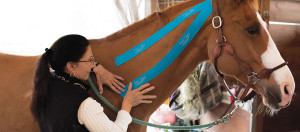Chiropractor Beverly Gordon, Creator Of Equi-Tape
Story by Deborah Welky
Photos by Abner Pedraza
With a background in exercise physiology and biomechanics, Dr. Beverly Gordon had worked for years as a chiropractor when she had a startling realization — the kinesiology tape that works so well on humans could probably be adapted for use on horses.
Gordon spends seven months of the year in Wellington, the winter equestrian capital of the world, so she vowed to give it a try.
After an intense period of research and development by her company, the Horse in Motion, Equi-Tape was ready for market in early 2005. Since then, it has been increasingly embraced by horse owners and trainers.
“The tape has so much application for performance horses here,” Gordon said. “It really helps horses train harder and stay sounder. It has a lot of applications on injured backyard horses as well.”
That is something Gordon has expertise in. Her chiropractic practice includes consulting for a number of veterinary facilities regarding chiropractics and equine movement.
Equi-Tape is an elastic cotton, two-way stretch tape with advanced adhesive properties for ease of application, removal and placement longevity. The way Equi-Tape affects the body is completely different from what non-elastic athletic tape does, and is based on its ability to interact with the skin and associated neurosensory and mechanoreceptors.
Equi-Tape does not compress the tissue as do other types of taping methods. Its design characteristics and application techniques decompress tissue, allowing for increased circulation. The lifting principle behind the decompression also affects how pain receptors respond to the messages associated with swelling and inflammation.
Depending on how the tape is applied, it can decrease pain and swelling; increase circulation; support joints, ligaments and tendons; speed the recovery of injured tissue; and/or reduce spasm and tension in tight muscles.
The caveat is making sure that the tape is applied correctly. As with any health aid, a certain degree of knowledge is required to achieve optimum results. To that end, Gordon created Equi-Tape Educational Services, offered through RSB Animal Health, a company headed up by CEO James Ruder that also markets and distributes Equi-Tape.
Equi-Tape and its accompanying Continuing Education Unit-accredited educational courses are now available throughout the world. Used in conjunction with other modalities, it can give competition horses an edge.
“We’ve been using kinesiology tape for 30 years in humans,” Gordon said. “You can’t watch a tennis match, basketball game or golf tournament without seeing someone with the tape on. It became particularly popular after being seen in use by Olympians in the 2012 Summer Games.”
Equi-Tape is the first and only elastic kinesiology tape designed specifically for horses. “That’s what makes it so special,” she said. “I tape horses from every discipline at every level — polo, jumpers — it increases circulation, which increases healing and decreases recovery time. Massage, magnets and lasers are all used to bring blood to an area. If you do those modalities and then put the tape on, it makes the effects last much longer. Plus, you can leave the tape on for up to four days.”
Gordon said that while Equi-Tape is easy and safe, a certified Equi-Tape professional will come out to properly assess each horse, then show the trainer, owner and rider how to use it, so they know exactly where to place the tape to get the results they are trying to achieve.
Equi-Tape can aid the equine athlete in both training and conditioning, as well as in rehabilitation and clinical recovery.
“When they warm up, it improves the warmup,” Gordon said. “When training, it supports the joints. It helps them train with less stress. And, after they show, the horses sometimes are sore, particularly jumpers. Performance horses need to stay sound to perform better. Equi-Tape brings blood and oxygen to the muscles and takes away toxins so they stay sore for less time and recover quicker.”
Ruder, the product’s distributor, agreed.
“I have spent my entire life immersed in the equestrian industry as a trainer, master farrier and businessman,” he said. “I have partnered with many equestrian companies since the early 1980s, successfully leading their sales and marketing efforts on a global scale. Late in 2012, I was introduced to the work that Dr. Beverly Gordon was doing in the area of equine kinesiology and, in particular, the effect of kinesiology tape on the equine athlete.”
To Ruder, Equi-Tape stood out as a quality product.
“I was fascinated with the effect that this simple modality had on the wellness of the equine athlete, not only in training preparation, but in therapy and recovery from injury,” Ruder said. “This fascination has evolved into a partnership with Dr. Gordon. Bev is an industry visionary. The good work that she has done will forever change the nature and approach to equine wellness.”
Gordon urged equine professionals who have not used Equi-Tape to give it a try.
“To me, it makes no sense for people not to be using the tape,” she said. “It’s safe, inexpensive, easy to use and works great.”
To learn more about Equi-Tape, visit www.equi-tape.com.
